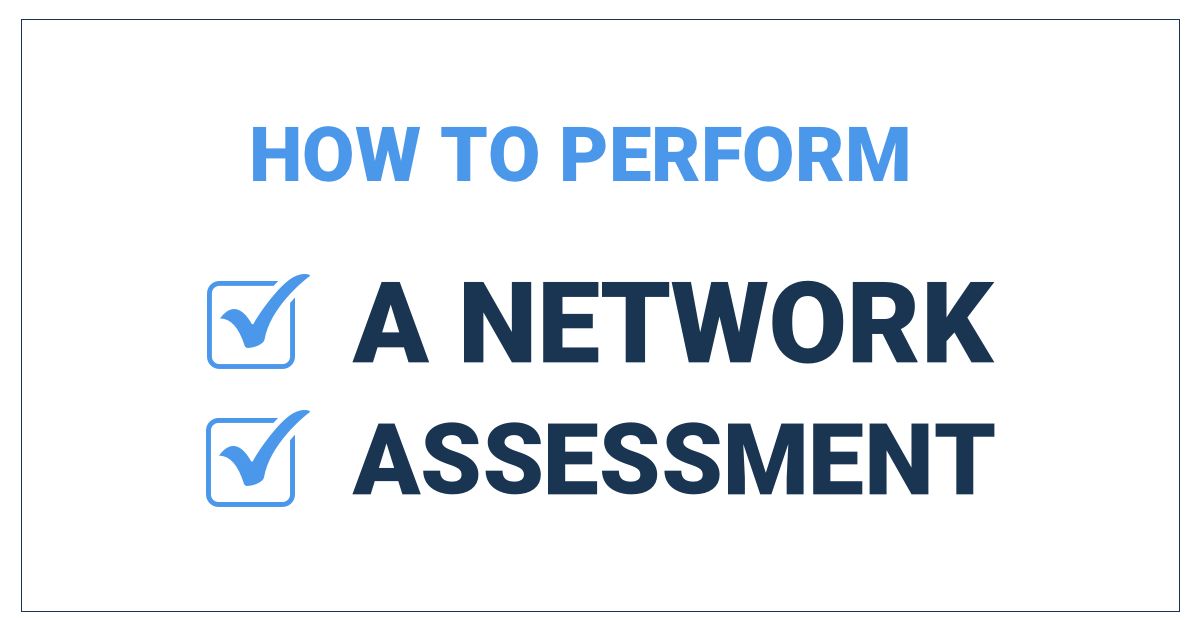Table of Contents
Table of Contents
Are you tired of feeling like you're in the dark about the services you're paying for? Are you getting what you paid for? Many businesses are in the same boat when it comes to Service Level Agreement (SLA) monitoring and reporting. It’s great having an SLA (or Service-Level Agreement) for the provision of a service, but you need to go further to really understand if the standards specified in the SLA are actually being met. That’s where SLA monitoring and reporting comes in.
Today we're going to shed some light on this topic and help you figure out if you're truly getting what you paid for. So grab a cup of coffee, sit back, and let's dive into the world of SLA monitoring and reporting!
Service-Level Agreements are publicly stated or implied contracts with users. An SLA in networking is a formal and negotiated contract or agreement between a network service provider (such as an Internet Service Provider or ISP) and a customer (which can be an individual, business, or organization).

Not all SLAs are built the same. Depending on the relationship, what’s being delivered, and how things are structured, there are a few different flavors. Here’s a breakdown:
1. Customer-Based SLA
This one’s all about a specific customer. It’s a tailored agreement between the provider and one client, covering all the services they use. Think of it like a personalized deal — if your company uses a vendor for both internet and cloud storage, a customer-based SLA might wrap all those services under one agreement with specific terms just for you.
2. Service-Based SLA
Here, the focus is on one specific service, and the SLA applies to anyone using it. For example, if a company offers email hosting, they might promise 99.9% uptime for every customer using that service — same rules, no matter who you are.
3. Multilevel SLA
This one’s the most layered. A multilevel SLA breaks things down into tiers — maybe company-wide terms, department-specific rules, and then user-level details. It’s super flexible and works great in big organizations where different teams have different needs.


The purpose of an SLA in networking is to define the specific terms, conditions, and performance expectations related to the delivery of network services. Here are the key elements you'll see in a networking-related SLA:
Service Description: An SLA typically starts with a detailed description of the network services being provided. This section outlines the scope of services, including internet connectivity, network uptime, bandwidth availability, and any additional services such as security features or technical support.
Performance Metrics: The SLA specifies various performance metrics and service levels that the provider commits to meet. Common metrics include network uptime (network availability), latency, packet loss, and jitter. These metrics define the quality of service the customer can expect.
Uptime and Availability: One of the most critical aspects of a network SLA is the uptime or availability commitment. This indicates the percentage of time the network is guaranteed to be operational. For example, a common SLA might guarantee 99.9% uptime, allowing for only minimal downtime per year.
Latency: SLAs often include maximum latency values, defining the allowable delay in data transmission between network points. Lower latency is crucial for real-time applications like video conferencing or online gaming.
Packet Loss: Packet loss can impact the reliability of network communication. An SLA may specify an acceptable packet loss rate, ensuring that a certain percentage of data packets are successfully delivered without loss.
Jitter: Jitter is the variation in packet arrival times, and it can affect the quality of voice and video communications. SLAs may include jitter limits to ensure stable and predictable network performance.
Bandwidth and Throughput: Some SLAs specify minimum or maximum bandwidth levels, ensuring that customers receive the agreed-upon data transfer rates. Throughput requirements can also be part of the agreement.
Technical Support: Network SLAs often outline the level of technical support and customer service the provider offers. This can include response times for addressing service issues and the availability of support staff.
Service Credits and Penalties: In case of SLA violations, many agreements include provisions for service credits or penalties. Service credits may involve discounts or compensation for downtime exceeding the agreed-upon limits.
Termination and Renewal: The SLA typically includes terms related to contract termination, renewal, and the notice period required for making changes or discontinuing services.
An SLA in networking is a critical document for both customers and service providers, as it sets clear expectations, ensures accountability, and provides a basis for resolving issues related to network services. It helps businesses and organizations make informed decisions about their network service providers and ensures that their networking needs are met reliably and consistently.
But, when problems arise with a given service, whether they’re VoIP problems, Internet problems, or network problems, users can’t help but wonder “Am I really getting what I was promised?”

SLA Monitoring (or Service-Level Agreement Monitoring) is the process of measuring, tracking, and analyzing a variety of metrics associated with a given service in order to calculate the service level of a deployed software or service and compare it against the agreed upon SLA requirements.
SLAs in networking are formal agreements between a service provider and its customers that define the expected level of service quality, response times, availability, and other performance-related aspects. Monitoring these SLAs is critical to ensure that the service provider consistently meets its obligations and that the agreed-upon service standards are maintained.
This process can include measuring metrics, creating reports and dashboards, setting up alerts, and more.
Now, you may be wondering if you really need to monitor your SLA. Well, the truth is that your Service Provider won't do it for you. And they won't be the ones to notify you if your service isn't performing as promised. So if you really want to know if you're getting what you paid for, SLA monitoring is for you!
Monitoring, reporting and measuring an SLA (Service Level Agreement) involves assessing the performance of a service provider against the specific criteria and targets outlined in the SLA. It can provide several benefits for both service providers the customers, including:
- Accountability: Monitoring & measureming SLAs holds service providers accountable for meeting their commitments. It provides an objective way to evaluate whether the promised service levels are being achieved. This accountability encourages service providers to strive for consistent performance and meet customer expectations.
- Ensuring service Quality: Monitoring and reporting on SLAs can help service providers ensure that they are delivering the expected level of service quality to their customers. This can help build customer trust and loyalty.
- Identifying areas for improvement: By monitoring SLA performance, service providers can identify areas where they can improve their services and processes to better meet customer needs and expectations.
- Early detection of issues: Monitoring SLAs can help service providers detect issues or potential problems early, allowing them to take corrective action before the issue becomes a major problem for the customer.
- Managing customer expectations: SLA monitoring and reporting can help manage customer expectations by providing a clear understanding of the level of service they can expect to receive.
- Resolving disputes: If a dispute arises between the service provider and the customer regarding service levels, the SLA can be used as a reference point for resolving the issue.
- Visibility and Transparency: SLA monitoring provides real-time or periodic insights into the performance of the service provider. This transparency ensures that both the service provider and the customer have a clear understanding of how well the service is meeting its commitments, fostering trust between the parties.
Overall, monitoring and reporting on SLAs can help service providers and customers work together more effectively to ensure that the service being provided meets the agreed-upon level of quality and helps drive business success.
Here’s how to do that:
SLA monitoring requires data and attention to detail.
Service Providers need to make sure that they meet the terms of the SLA, and users need to check that the service they paid for has been provided.
The best way to achieve this is by deploying a continuous, end-to-end Network Monitoring tool, like Obkio Network Performance Monitoring software.

Obkio uses synthetic traffic to measure performance every 500ms and monitor:
- Your local network (LAN monitoring, VPN) and third-party networks (WAN, ISP, and Internet Peering)
- Applications like VoIP (or VoIP PBX), Unified Communications (Zoom and Microsoft Teams)
- Network devices like Firewalls, routers, and switches
- Services like SD-WAN, MPLS, Dual-WAN and SASE
- And, most importantly, the end-user experience
Deploying a tool like Obkio in all your key network locations allows you to automate the SLA monitoring process and collect and share the information you need to monitor your service-level agreement.

Performance metrics typically measure technical aspects of network performance and uptime. These metrics are used to evaluate how well the network is performing in terms of delivering data between different points.
For example, a network administrator might use performance metrics to assess how quickly a file can be transferred from one computer to another, or how many packets are being dropped due to network congestion.
Some common performance metrics for SLA monitoring include:
- Jitter: A disruption that occurs while data packets travel across the network.
- Packet Loss: The number of data packets that were successfully sent out from one point in a network, but were dropped during data transmission and never reached their destination.
- Latency: The measure of time it takes for data to reach its destination across a network.
- VoIP Quality: The quality of Voice over Internet Protocol (VoIP) calls transmitted over the network. VoIP quality metrics evaluate the clarity, reliability, and consistency of voice communication
- Throughput: The amount of data passing through the network from point A to point B in a determined amount of time.
- Bandwidth: The maximum amount of data that a network connection can transmit within a specific time frame.
- Network Availability: The amount of time that the service is available to users. Availability is typically expressed as a percentage, such as 99.9% uptime.
- Network Error Rate: The percentage of packets that are lost or corrupted during transmission across a network.
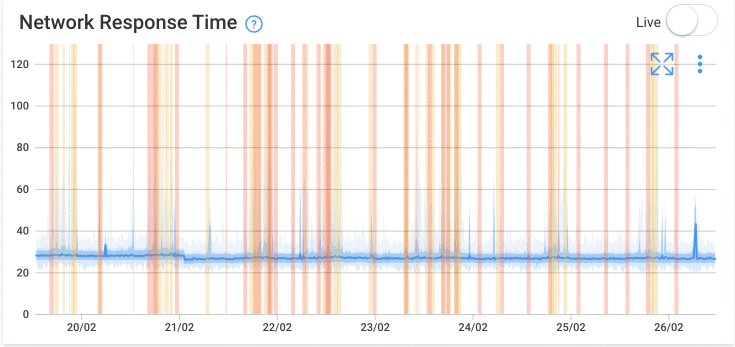

Measuring these network performance metrics act as Service Level Indicators (SLIs) that will help you understand how your network, application, or service is really performing. High levels of packet loss or jitter, for example, can be a sign that your network is not performing as it should be - or as your SLA intended.
Obkio continuously measures these key network metrics in real-time so you always know how your network is performing, and can proactively identify performance issues.
A big part of SLA monitoring is understanding whether the performance of an application or service is meeting the user requirements, as intended by the SLA.
One way to identify that is by measuring user experience metrics.
User experience metrics, on the other hand, are focused on the end-user experience of using the network. These metrics measure how the user perceives the network performance, and can include factors such as page load times, application response times, and overall user satisfaction. User experience metrics are important because they give network administrators insight into how well the network is meeting the needs of the users who rely on it.

- User Quality of Experience: The perception of the user of the effectiveness and quality of the system or service.
- Customer Satisfaction: Customer satisfaction measures how satisfied users are with the service. This metric can be measured through surveys or other feedback mechanisms and can provide valuable insights into user perceptions of the service.
- Network Response Time: The time it takes for the service to respond to user requests. This metric is critical for ensuring that the service is providing a timely and responsive experience for users.
- MOS (Mean Opinion Score): A rating from 1 to 5 of the perceived quality of a voice call, 1 being the lowest score and 5 the highest for excellent quality.
Obkio uses synthetic traffic (synthetic monitoring) to simulate the end-user experience when using various applications like VoIP or Video, to interpret the performance that users are actually experiencing.
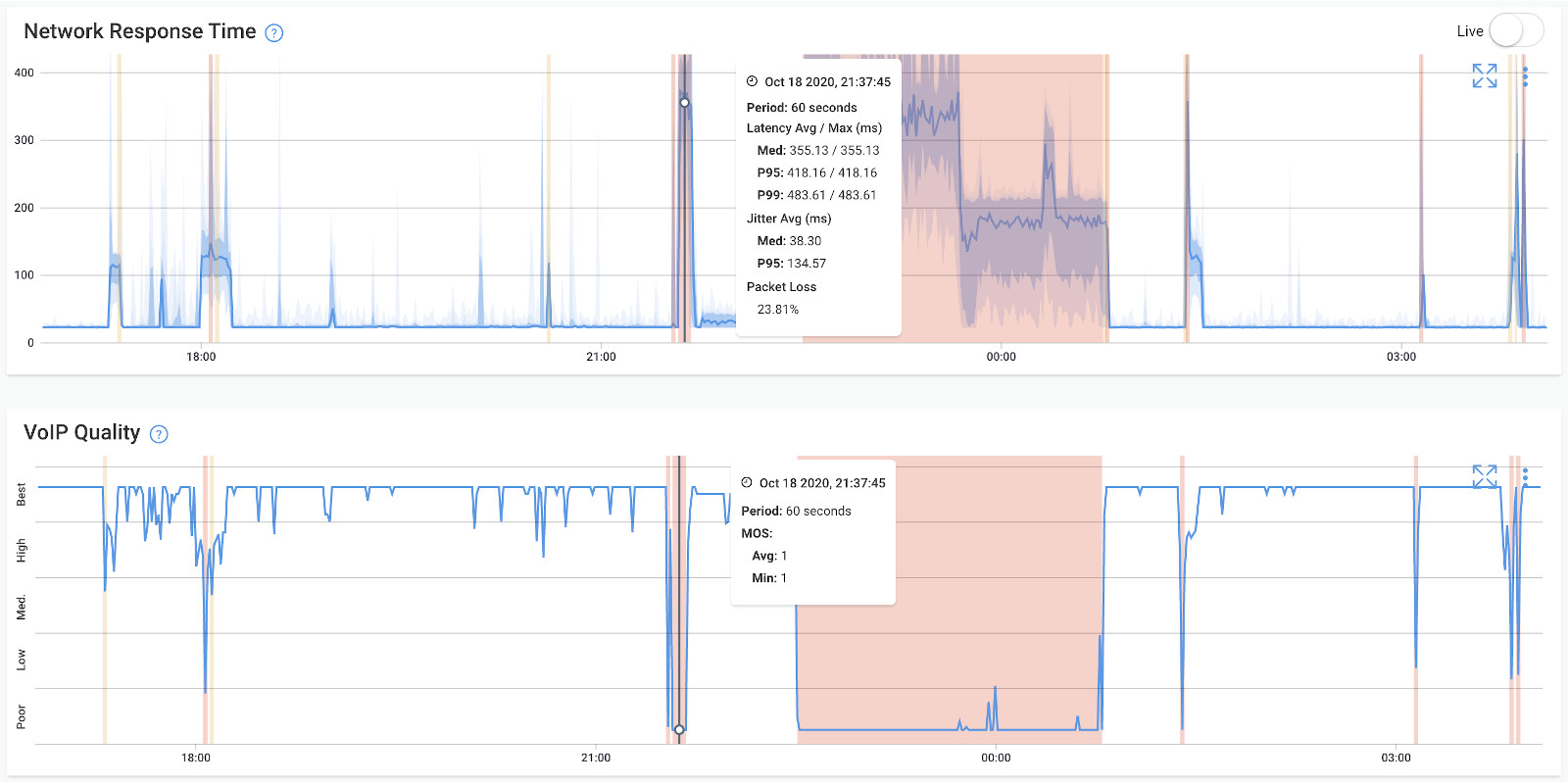
In addition to user experience metrics, monitoring SLA metrics helps both parties track performance and maintain accountability.

- Response Time: This measures how quickly a service provider acknowledges a customer's request or issue. It's often divided into different levels, such as "first response time" (time to first acknowledge) and "resolution time" (time to fully resolve the issue).
- Uptime/Availability: This metric is critical for services like websites, cloud platforms, or online applications. It measures the percentage of time the service is operational and available to users. Aim for as close to 100% uptime as possible.
- Service Reliability: This metric measures the consistency of service delivery. It can include measures like Mean Time Between Failures (MTBF) and Mean Time To Repair (MTTR) for infrastructure or equipment.
- Throughput: For services that involve processing tasks or transactions, throughput measures the rate at which these tasks are completed. It helps ensure that the service can handle the expected load.
- Response and Resolution Times by Priority: Different types of issues or requests may have varying levels of importance. Monitor response and resolution times for different priority levels to ensure critical issues are addressed promptly.
- Service Level Compliance: This metric assesses whether the service provider is meeting the SLA requirements as agreed upon in the contract. It involves comparing actual performance against the defined SLA targets.
- Incident Management Metrics: This includes metrics related to how incidents are handled, such as the number of incidents, incident response times, and the effectiveness of incident resolution.
- Customer Satisfaction (CSAT): While not a technical metric, CSAT scores provide valuable feedback on how satisfied customers are with the service. It's usually measured through surveys or feedback forms.
- Service Capacity and Scalability: Monitor resource and network utilization and the ability to scale resources up or down as needed to ensure the service can handle changing demand.
- Error Rates and Quality Metrics: For services involving data processing or content delivery, keep an eye on error rates, data accuracy, and content quality to ensure a high level of service quality.
- Security and Compliance Metrics: Ensure that security measures are in place and that the service complies with relevant regulations. Monitor metrics related to security incidents, vulnerabilities, and compliance checks.
- Cost Metrics: For services with cost implications, track cost-related metrics to ensure that the service is within budget. This can include tracking operational expenses and resource utilization.
- Backup and Recovery Metrics: If data backup and recovery are part of the SLA, monitor metrics related to backup success rates, recovery time objectives (RTOs), and recovery point objectives (RPOs).
- Change Management Metrics: Measure the success and impact of changes made to the service to ensure they do not negatively affect performance or availability.
- Documentation and Reporting: Ensure that documentation is up to date and that regular reports are provided to the customer, summarizing SLA performance.
The data from performance metrics, user experience metrics and SLA metrics will help you understand if your performance and user experience are meeting the SLA requirements. Service Providers can also measure these metrics to proactively address issues and maintain high levels of customer satisfaction.
Another big part of SLA monitoring and reporting is collecting and analyzing historical data.
Obkio measures and collects historical network performance data, so you can analyze, compare, and troubleshoot performance from the past.
This allows you to:
- Identify if your application or service performance stops meeting SLA requirements
- Pinpoint intermittent performance issues like intermittent Internet connection
- Diagnose performance issues from the past
- Share performance data with your Service Provider over a longer period of time
Performance isn’t always stable, so network testing is important to understand how your network or application is performing in real-time, but also throughout a longer period of time to keep your SLA accountable.
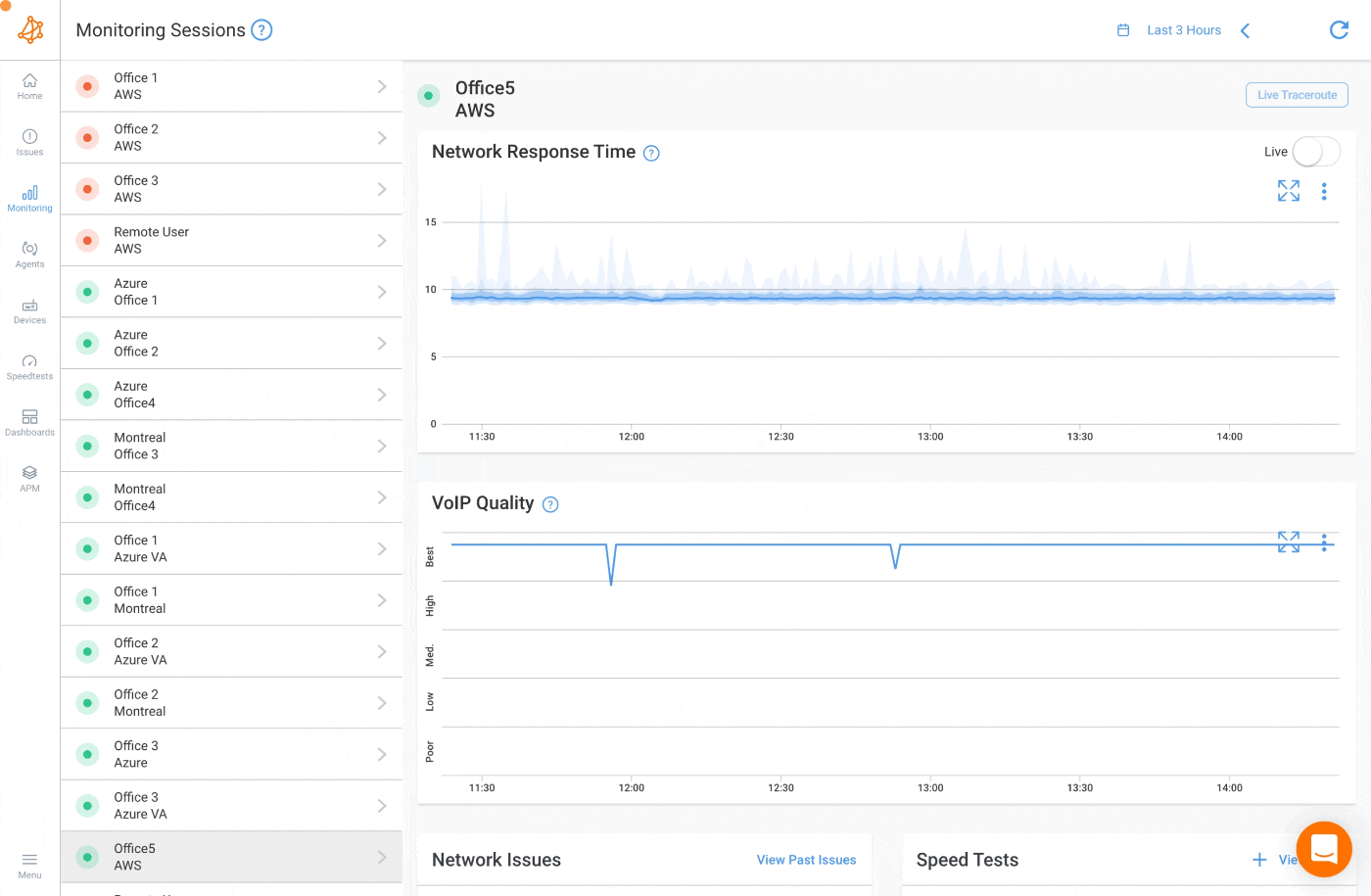
In larger, more complex networks, you may have many services, applications and network locations to monitor. So how can you drill-down on the data that matters for your SLA reporting?
Obkio allows you to create customizable, real-time dashboards so you can visualize the data related to your SLA all in one place.
Track the performance of your network and service in one place, and how they impact other services, network locations and users
You can also include graphs and charts of various network locations or applications that you’re currently monitoring.
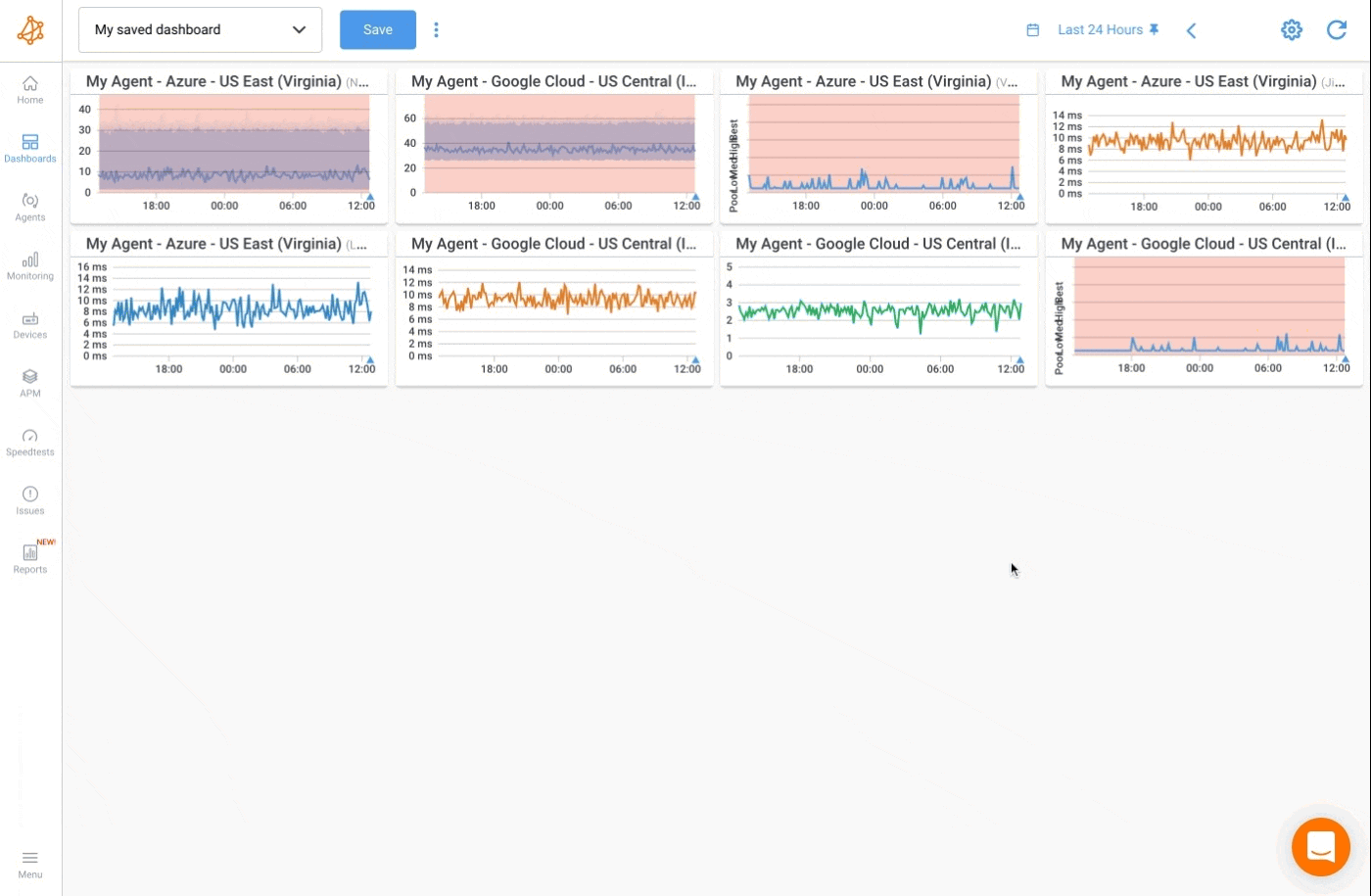

A well-designed SLA (Service Level Agreement) dashboard for networking and performance monitoring should provide a clear and comprehensive view of the key metrics and performance indicators that are essential for evaluating the health and compliance of network services. Here are some elements you should consider including on an SLA dashboard for networking and performance:
1. Uptime and Availability:
- Real-time uptime status: Display the current network uptime percentage.
- Historical uptime trends: Show uptime performance over a specified period, such as days, weeks, or months.
2. Latency and Response Times:
- Latency metrics: Display real-time and historical latency values, including average, minimum, and maximum latencies.
- Response time trends: Provide insights into how response times fluctuate during different times of the day or week.
3. Packet Loss and Jitter:
- Packet loss rate: Monitor and display the current and historical packet loss rate.
- Jitter values: Show real-time jitter values and trends to assess network stability.
4. Bandwidth Utilization:
- Bandwidth usage: Present current bandwidth utilization levels and historical trends.
- Bandwidth allocation: Compare actual bandwidth usage with the allocated or contracted bandwidth.
5. Throughput:
- Throughput metrics: Display real-time and historical throughput data, both in terms of upload and download speeds.
- Peak throughput: Identify the peak throughput achieved during specific periods.
6. Incident Alerts:
- Real-time alerts: Highlight ongoing incidents or outages and provide details about their nature, impact, and expected resolution times.
- Incident history: Keep a log of recent incidents, including their duration and resolutions.
7. SLA Compliance:
- SLA performance metrics: Compare current performance against SLA targets for uptime, latency, packet loss, and other critical parameters.
- Compliance trends: Track how well SLA compliance has been maintained over time.
8. Geographical Insights:
- Geographic performance: If applicable, include a map visualization showing network performance across different geographic locations or regions.
- Latency heatmaps: Use color-coded heatmaps to indicate latency levels in various geographical areas.
9. Resource Utilization:
- Resource usage: Monitor resource consumption, such as CPU usage, memory, and network device utilization.
- Resource trends: Show how resource utilization changes over time and in response to network traffic fluctuations.
10. Historical Performance Data:
- Offer the ability to access historical performance data for in-depth analysis, troubleshooting, and trend identification.
A well-designed SLA dashboard should present this information in a clear and visually intuitive manner, using charts, graphs, color coding, and alert icons to facilitate quick understanding and decision-making regarding network performance and compliance with SLAs.
For many businesses, not meeting their SLAs is serious business. If you’re the service provider creating the SLAs, it could seriously affect your reputation.
So, in addition to creating custom dashboards, Obkio allows you to set up automatic alerts (or Smart Notifications) around SLA-specific metrics that matter to you most.
They can be raised because a Network Issue is detected (such as high packet loss), when a network device is down, when there's a network outage or when there’s a big change, or even a slight change, in network performance.
Automatic network monitoring alerts automate the SLA monitoring process so you know when your performance expectations aren’t being met.
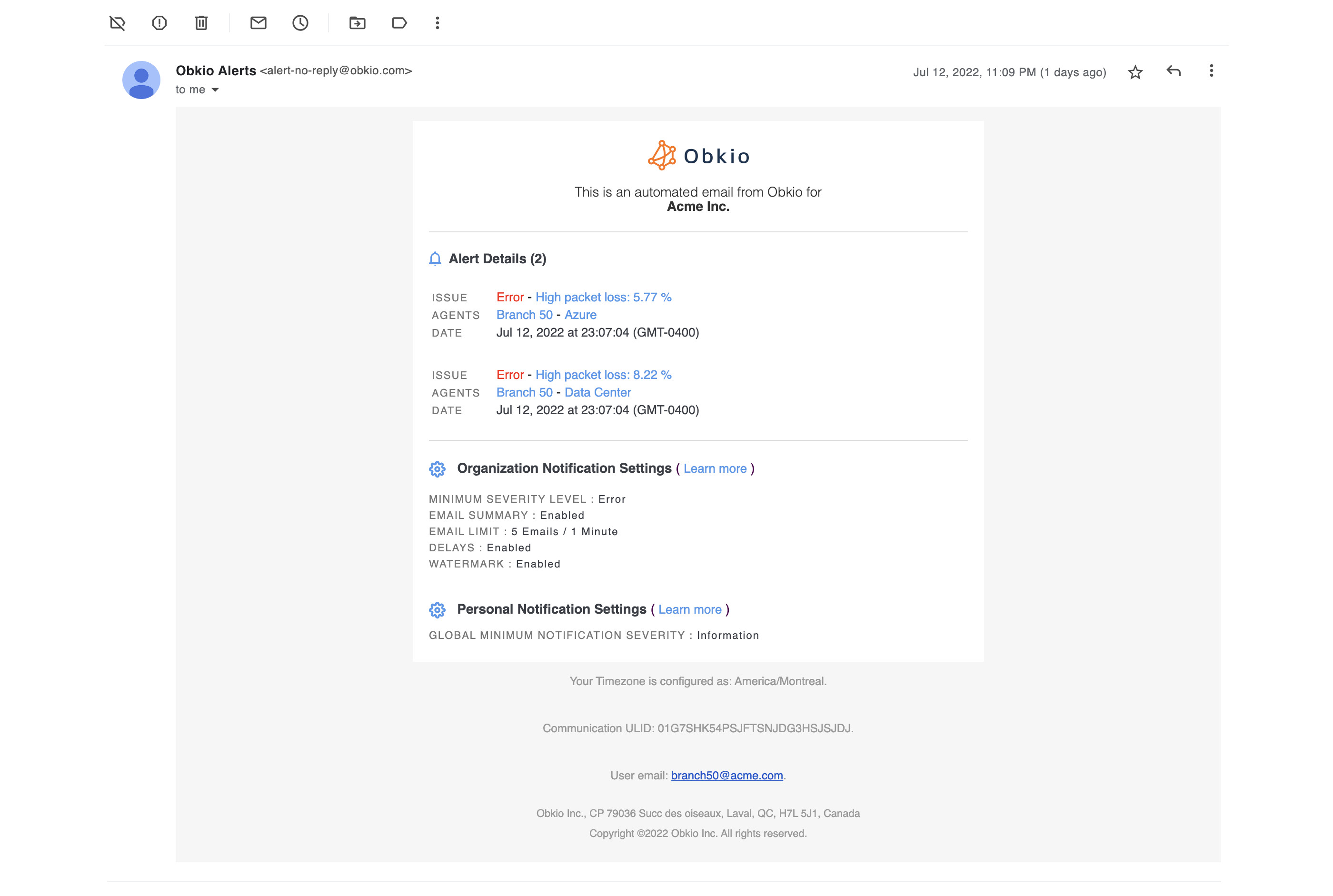
Now let's get to the results!
SLA monitoring involves tracking key performance indicators (KPIs) that are outlined in the agreement, and generating regular reports is an effective way to keep stakeholders informed about the service provider's performance.
The information you can collect in Obkio Network Performance Monitoring App gives you a precise and continuous view of your network performance. Obkio’s Network Performance Reports feature helps you extract and analyze a large amount of data from Obkio’s App all at once.
SLA Reporting refers to the process of tracking and reporting the performance of a service provider against the Service Level Agreement (SLA) that has been agreed upon with their clients or customers. An SLA is a contractual agreement that defines the level of service that a provider is expected to deliver, including metrics such as uptime, response time, and resolution time.
SLA Reporting typically involves gathering data on the provider's performance, analyzing the data to determine whether the provider is meeting the agreed-upon SLA targets, and presenting the findings in a report to the customer or client. The report may include information on key performance indicators (KPIs), such as availability, response time, and mean time to repair (MTTR), as well as any breaches of the SLA that have occurred.
SLA Reporting is an important aspect of ensuring that service providers are held accountable for delivering the level of service that they have agreed to provide, and that customers or clients have visibility into the provider's performance. By regularly reviewing SLA reports, customers or clients can make informed decisions about whether to renew their contracts with a provider, or to seek out other providers who may better meet their needs.
Obkio's reports can provide a wealth of information about SLA performance, including metrics such as availability, response time, throughput, and network error rate. Reports can also provide trend analysis and other data visualization tools that make it easy to identify patterns and trends in performance over time.
- Summarize Data: Generate reports to view network metrics, show moments of network performance degradation, or highlight network issues.
- Download Reports: Download reports using a public URL. Users don’t need to have a user created in Obkio’s App to download reports.
- Share Reports: Send reports via email to a list of email addresses to send reports to multiple contacts at once.
- Schedule Reports: Schedule reports to run and be generated on a daily, weekly or monthly basis. Learn more about Report Schedules.
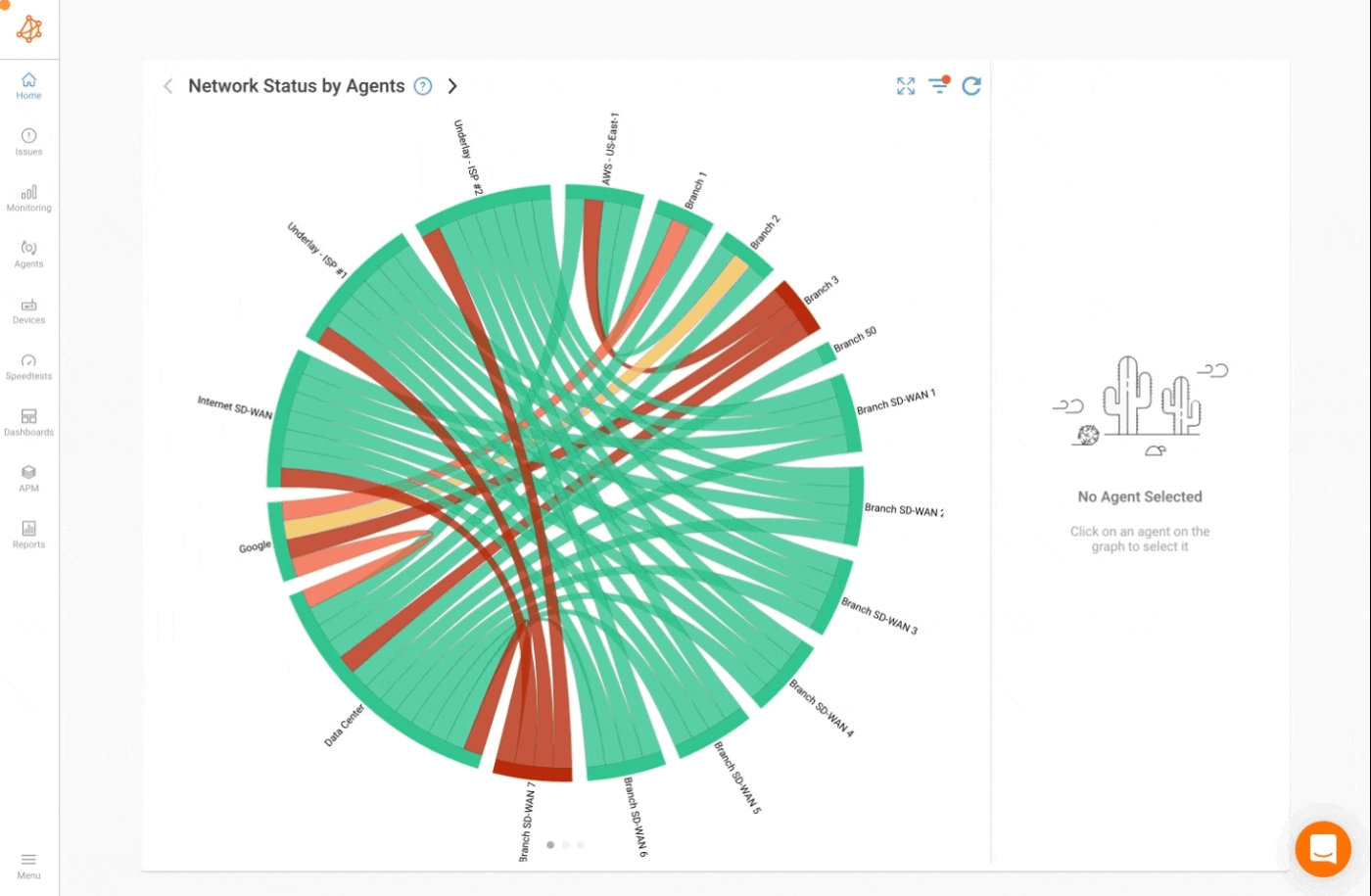
In addition to providing valuable insights into SLA performance, SLA reporting also has many other benefits for both Service Providers and their customers
Certainly! Here's a breakdown of the benefits of SLA reporting for both service providers and customers:
- Performance Measurement: SLA reporting allows service providers to assess their performance against agreed-upon service levels, helping them understand their strengths and areas for improvement.
- Transparency and Accountability: SLA reporting promotes transparency by providing clear visibility into service levels, fostering trust with customers. It also holds service providers accountable for meeting their obligations.
- Continuous Improvement: By analyzing SLA reports, service providers can identify trends, bottlenecks, and areas for improvement, allowing them to enhance efficiency and optimize their service delivery processes.
- Contractual Compliance: SLA reports serve as evidence of service performance, ensuring service providers adhere to their contractual obligations. It helps resolve disputes or claims related to service levels.
- Decision-Making and Planning: SLA reports provide valuable insights for resource allocation, capacity planning, and service expansion. They assist service providers in making informed decisions about their service offerings.
- Performance Assessment: SLA reporting enables customers to measure and evaluate the performance of their service providers objectively. They can assess if the service levels meet their expectations and identify areas for improvement or potential concerns.
- Transparency and Accountability: Customers benefit from clear visibility into service levels and performance. They can hold service providers accountable for any deviations from the agreed-upon levels and ensure their concerns are addressed.
- Effective Communication: SLA reporting facilitates effective communication by providing a common framework for discussing service performance. Customers can engage in proactive discussions, problem-solving, and collaboration with their service providers.
- Contractual Compliance: SLA reports provide customers with evidence of service performance, ensuring service providers fulfill their contractual obligations. Customers can refer to SLA reports to validate compliance and seek remedies if necessary.
- Informed Decision-Making: SLA reports help customers make informed decisions about their service providers. They can evaluate the provider's performance, compare it with alternatives, and decide whether to renew or seek new service contracts.
Overall, SLA reports are an important tool for monitoring SLAs, and should be generated regularly and shared with all relevant stakeholders. By leveraging the insights provided by reports, both service providers and customers can work together to ensure that SLAs are being met and that the service is meeting the needs of its users.
One of the primary objectives of SLA monitoring is to identify and address the various factors and issues that can impact the performance of service providers. Several factors can affect SLA (Service Level Agreement) performance, influencing whether a service provider can meet the agreed-upon service standards and targets. In the pursuit of consistently meeting the agreed-upon service standards and targets, it is crucial to recognize and mitigate both internal and external factors that can influence SLA performance.
- Resource Allocation: The allocation of resources, including hardware, software, and personnel, can directly impact SLA performance. Inadequate resources or improper allocation can lead to delays and service disruptions.
- Infrastructure and Technology: The state of the underlying infrastructure and technology can affect performance. Outdated or poorly maintained hardware and software may lead to slower response times or increased downtime.
- Capacity Planning: Failure to accurately forecast and plan for changes in service demand can result in overloading the system or underutilizing resources, both of which can impact SLA performance.
- Process Efficiency: Inefficient workflows and processes within the service provider's organization can slow down service delivery, affecting response times and overall service quality.
- Staffing and Training: The availability and competency of personnel can influence SLA performance. Insufficient staffing or inadequately trained staff may struggle to meet service demands effectively.
- Software Bugs and Errors: Software glitches, bugs, or errors can lead to unexpected service disruptions or decreased service quality.
- Network and Connectivity Issues: External factors like network outages, connectivity problems, or internet disruptions can affect the ability to deliver services as per the SLA.
- Third-Party Services: Dependencies on third-party services or vendors can introduce risks. If a third-party service experiences downtime or performance issues, it can cascade into the primary service and impact SLA performance.
- Natural Disasters and Environmental Factors: Events like natural disasters, extreme weather conditions, power outages, or other environmental factors can disrupt service delivery and affect SLA performance.
- Security Incidents: Security breaches or cyberattacks can compromise service availability, data integrity, and confidentiality, impacting SLA performance.
- Customer Actions: Customer actions, such as high volumes of simultaneous requests or misuse of the service, can strain resources and affect performance for other users.
- Regulatory and Compliance Changes: Changes in regulations or compliance requirements may necessitate adjustments to the service, potentially impacting SLA performance.
- Geographic Location: The geographic location of service users and data centers can influence latency and access times, which in turn affect service responsiveness and performance.
- Economic Factors: Economic fluctuations or budget constraints can impact resource allocation and investment in technology, which can affect SLA performance.
- Market Demand: Rapid increases in market demand or unexpected spikes in user activity can strain resources and impact service performance if not properly anticipated and managed.
- Vendor Reliability: When using external vendors or cloud service providers, the reliability and availability of these third-party services can have a direct impact on SLA performance.


If you're looking to go beyond SLA monitoring and reporting, let us introduce you to the concept of SLA Management.
SLA (Service Level Agreement) management is the process of defining, monitoring, and ensuring the fulfillment of service level agreements between a service provider and its customers. It involves the establishment of clear and mutually agreed-upon expectations for the quality, performance, and availability of a service. SLA management is essential in various industries, including IT services, cloud computing, telecommunications, and outsourcing, where service providers commit to meeting specific service standards.
Here are the key components of SLA management:
- Definition of SLAs: The process begins with defining SLAs, which are formal contracts or agreements that outline the service provider's commitments and the customer's expectations. SLAs should be clear, measurable, and include specific metrics and targets.
- Service Level Objectives (SLOs): SLOs are specific, quantifiable performance objectives that describe what the service provider aims to achieve within the SLA. These objectives serve as the basis for monitoring and measuring performance.
- Key Performance Indicators (KPIs): KPIs are metrics used to evaluate performance against the SLAs and SLOs. They can include response times, uptime percentages, error rates, and other relevant measurements.
- Monitoring and Measurement: Continuous monitoring of service performance is a crucial aspect of SLA management. This involves collecting data on KPIs in real-time or on a regular basis to assess whether the service provider is meeting the agreed-upon standards.
- Alerting and Reporting: When performance deviates from the agreed-upon standards, alerting mechanisms can notify both the service provider and the customer. Regular reports are generated to summarize performance and provide transparency.
- Escalation Procedures: SLAs often include escalation procedures that define the steps to be taken when performance issues arise. These procedures ensure that issues are addressed promptly and at the appropriate organizational level.
- Review and Improvement: SLAs are not static documents; they should be periodically reviewed and updated to reflect changing business needs and technology advancements. This iterative process helps in continuous improvement.
- Compliance and Penalties: SLAs may specify penalties or compensation mechanisms if the service provider consistently fails to meet the agreed-upon standards. These financial or contractual consequences incentivize adherence to SLAs.
- Contract Management: SLA management often involves contract management to ensure that the contractual agreements align with the SLAs and that all parties fulfill their obligations.
SLA management is not only about ensuring that service providers meet their commitments but also about building trust, maintaining a positive customer-provider relationship, and ensuring that the service aligns with the customer's business objectives. It is a dynamic process that requires ongoing collaboration and communication between the service provider and the customer to ensure the service's quality and performance meet expectations.
SLA monitoring is a subset of SLA management. Monitoring is the act of tracking and measuring performance against predefined metrics, while management involves a more comprehensive set of activities related to defining, negotiating, establishing, monitoring, and improving SLAs.
SLA management encompasses the strategic and operational aspects of ensuring that service expectations are met, while SLA monitoring is specifically focused on measuring and reporting on performance. Both are essential for maintaining effective SLAs and ensuring that service providers consistently deliver the expected level of service quality.
1. SLA Monitoring:
- Focus: SLA monitoring primarily centers on the ongoing tracking, measurement, and observation of key performance indicators (KPIs) and service-level objectives (SLOs) outlined in the SLAs.
- Purpose: The main purpose of SLA monitoring is to assess whether the service provider is meeting the agreed-upon standards and targets as specified in the SLAs. It involves real-time or regular data collection and analysis to determine how well the service is performing.
- Activities: SLA monitoring involves activities such as collecting data on response times, uptime percentages, error rates, and other relevant metrics. It may include setting up alerts to notify stakeholders when performance deviates from the defined thresholds.
- Output: The output of SLA monitoring is typically data and reports that provide insight into the actual performance of the service. These reports can be used to identify trends, areas for improvement, and potential issues.
2. SLA Management:
- Focus: SLA management is a broader and more comprehensive process that encompasses the entire lifecycle of SLAs. It includes defining, negotiating, establishing, monitoring, and improving SLAs.
- Purpose: The primary purpose of SLA management is to ensure that the service provider and the customer have a clear understanding of the service expectations and that those expectations are met consistently over time. It involves not only monitoring but also strategic planning and governance.
- Activities: SLA management activities include defining SLAs, negotiating their terms, establishing performance targets, monitoring performance through SLA monitoring processes, addressing deviations, managing contracts, and continuously improving the service and SLAs.
- Output: The output of SLA management includes the initial SLA agreements, ongoing SLA performance reports, documentation of changes and updates to SLAs, and processes for addressing issues and making improvements.
After monitoring your SLA, you'll likely realize one of two things. Either:
- Your SLA is being met
- Your SLA isn't being met
If your Service-Level Agreement (SLA) isn't met, there are several steps you can take to address the issue:
- Notify your service provider: The first step is to notify the service provider that the SLA has not been met. Be specific about the issue and provide any relevant data or metrics that demonstrate that the SLA has not been met.
- Work with the service provider to identify the root cause: Once you've notified the service provider, work with them to identify the root cause of the issue. This may involve troubleshooting the issue together, or the service provider may need to conduct their own investigation.
- Determine the impact of the SLA breach: Depending on the severity of the SLA breach, you may need to determine the impact on your business. This could include calculating any financial losses, reputational damage, or other negative consequences.
- Negotiate a resolution: Once you've identified the root cause and determined the impact of the SLA breach, work with the service provider to negotiate a resolution. This may involve extending the SLA period, providing compensation or refunds, or implementing measures to prevent future SLA breaches.
- Monitor the situation: After a resolution has been reached, it's important to continue monitoring the situation to ensure that the SLA is being met going forward. This may involve ongoing monitoring and reporting of SLA metrics, as well as periodic reviews of the service provider's performance.
In some cases, it may be necessary to escalate the issue to a higher level within the service provider's organization or seek legal recourse if the SLA breach has significant financial or legal implications. However, in most cases, working collaboratively with the service provider to address the issue is the most effective way to resolve SLA breaches and maintain a productive working relationship.
In conclusion, when it comes to SLA monitoring and reporting, it's important to remember that knowledge is power. By tracking key performance indicators and generating regular reports, you can gain valuable insights into the performance of your service provider and ensure that you're getting what you paid for.
Plus, who doesn't love a good report? With colorful charts and graphs, you can turn even the most mundane data into a work of art. So, embrace the power of SLA monitoring and reporting, and let your metrics be your guide to a happier, more productive relationship with your service provider!
Once you have Obkio's Network Monitoring tool set up, Obkio’s Monitoring Agents will continuously monitor network and application performance and collect the data you need most.

Put It to the Test: Trying Is the Ultimate Way to Learn!
If you’re a user, you can finally understand if your service provider is respecting the SLA, and if not, you have the proof and data to keep them accountable.
If you’re a service provider, you can quickly find out if a user’s SLA is not being met, and take the necessary actions to fix the issue.
-14-day free trial of all premium features -Deploy in just 10 minutes -Monitor performance in all key network locations -Measure real-time network metrics -Identify and troubleshoot live network problems

You can rest assured that we're not like those pushy Sellsy people - there's no catch here. We firmly believe in the excellence of our product, but if it's not the right fit for you, we understand and want what's best for you.


























 Obkio Blog
Obkio Blog





